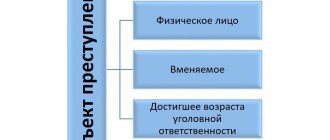A crime is a socially dangerous act committed by a person or group of people, prohibited by criminal law under the threat of punishment. To prove the commission of an illegal act, criminal law uses the corpus delicti. There is no definition of what constitutes a crime in the Criminal Code. The wrongfulness of an act is established by formulating the elements of a criminal act. It follows from the fact that each element of an illegal offense consists of a set of characteristics. And they are already characterizing it as a crime. A separate specific composition of an illegal act formulates its own type of offense.
So, the concept of corpus delicti is contained in various scientific sources, but not in the Criminal Code. Therefore, this issue may be debatable. Although it is precisely from the legislative definition of the conditions and grounds of criminal liability, the definition of a crime and the signs of specific offenses that the concept in question is formulated.
The corpus delicti in criminal law is a combination of subjective and objective factors. They define a socially dangerous act precisely as a criminal event. The set of signs that are sufficient and necessary to bring a guilty person to justice for a certain crime and regulated by a specific norm of the Criminal Code is a specific element of a criminal act.
Composition of the crime: concept, types, meaning
The composition of a criminal act can be considered not only as a set, but also as a system of characteristics that are characterized by internal unity. They can be grouped into individual elements that form a structure. What is this? The structure of the composition is an unchanging system of connections between its elements.
The concept of corpus delicti, which stems from the awareness of the illegal act itself, is a generalization of characteristics. And they are already separately taken from the crimes. Actually, they contain features that are common to all offenses provided for in criminal law and have a special meaning in criminal proceedings.
The corpus delicti in criminal law has its own meaning. It acts as the basis for the emergence of responsibility. It is also a prerequisite for qualifying an illegal act, a reason for imposing punishment by a court or other measures provided for by criminal law, and a guarantor of compliance with the rule of law.
The most important legal prerequisite for criminal liability is determined by the concept of corpus delicti and its meaning. This is explained by the fact that bringing a person to criminal liability occurs on the basis of all the elements of the crime. And each of them already has its own individual motive.
There are several types of illegal acts:
- Basic.
- Privileged.
- Skilled.
They have the following differences:
- According to the level of public danger.
- By its structure (complex and simple).
- According to the characteristics of the objective side described in the law, that is, the legislative structure (material, formal and truncated).
The main elements of the crime are expressed in the essence of the illegal act, as well as in its specific features. Privileged composition is a motive with mitigating circumstances. Simply put, it assigns the least public danger to a criminal act. Qualified composition is a motive that includes signs that increase the level of public danger of an act.
The legal composition of a crime in the Criminal Code does not always provide for a sequence of characteristics of all elements. For example, there are norms exclusively with the main motive of the act. This is an article about genocide, where the norm consists of only one part.
The simple composition of an illegal act simultaneously indicates the elements of a crime. In a complex motive, everything points to two forms of guilt, several objects, actions, etc. The complex composition has its own variety. This is an alternative form, characterized by several acts or several consequences, the presence of which is sufficient if other necessary signs exist for liability to occur.
The material composition of an illegal act is considered to be a crime that is completed from the moment the socially dangerous consequences occur. The formal composition is characterized by the fact that the criminal act is completed from the moment the socially dangerous act is carried out. A truncated crime is an illegal act that is considered completed from the moment of threat of the likelihood of harm from the commission of certain actions regulated by the disposition of criminal law norms.
The crime in criminal law includes several types. This is an independent type of illegal act. The elements of danger in it are understood to be complete from the very moment when a socially dangerous offense was committed, creating a threat of the consequences specified in the legislation.
So, the concept and types of crime help to correctly qualify a criminal act or inaction, determine the degree of damage or harm, the severity of the event, etc.
Types of crime
Material and formal
The material composition includes not only the act itself (action or inaction), but also the consequences.
For example, Article 110 “Incitement to suicide”. In addition to the act (= completion), the legislator also includes the consequences of this particular crime - suicide or attempted suicide.
Other examples: Article 349 “Violation of the rules for handling weapons and objects that pose an increased danger to others.”
The article also provides, along with the act, a consequence: grave harm to human health, destruction of military equipment, etc.
Article 250 of the Criminal Code of the Russian Federation on water pollution also has a material composition. Since this act, in order to become a crime, must entail certain consequences: significant harm to the animal or plant world, forests, etc.
The formal composition includes only the act. Despite the presence or absence of consequences, such an element of the crime as the objective side will be formed.
A good example would be Article 110.1 of the Criminal Code of the Russian Federation “Inducement to commit suicide.” In this case, the consequences of such criminal acts (i.e. whether suicide was attempted or not) will not be relevant to the formation of the crime.
The crime will still be committed, since there is an act that is expressed in inducing a person to commit suicide.
Other examples of formal composition: Article 302 “Force to give testimony” (the consequence in the form of the testimony itself is not important), Article 345 “Abandonment of a sinking warship” (the consequence - whether the ship sank or not - is not important).
This also includes a truncated composition. For him, not only the consequences are not important, but also whether the action was completed to the end.
Truncated offenses include, for example, murder and robbery.
Basic, qualified, privileged elements of crime
The main composition does not provide for any circumstances that mitigate or aggravate liability.
Qualified elements include aggravating circumstances. That is, circumstances that make the crime more serious. And therefore the punishment is more severe.
Carelessly storing a gun is one thing. It’s different if such storage resulted in the death of people. In this case, we have qualified personnel and more serious responsibility.
The privileged composition, on the contrary, includes circumstances that make the punishment less severe.
Example: Articles 107 and 113 of the Criminal Code of the Russian Federation. They talk about a state of passion, i.e. emotional instability. This condition mitigates responsibility for the crime.
Composition with different forms of wine
As we have already said, the subjective side of the crime may include the intent of the person to commit it or negligence.
Thus, if a crime is committed intentionally, it is a crime with intent . If due to negligence - composition, where the form of guilt is negligence . These are compounds with a single form of wine .
And crimes where both intent and negligence are present have two forms of guilt . Example: Article 251 of the Criminal Code of the Russian Federation on air pollution.
The act itself—pollution—is done with intent. But the death of other people can happen due to negligence. It turns out that there is a double form of guilt.
Compositions with different subjects
There are crimes with a common subject . That is, this is a mentally developed person of a certain age.
In Article 284 of the Criminal Code of the Russian Federation, the subject will be special . In order for there to be a crime, the person who has access to state secrets must lose secret documents.
Simple and complex elements of crime
A simple composition contains one element each: one object, one subject, one objective side and one subjective side.
Complex ones can be formed from several elements. For example, two subjects or two forms of guilt (intention and negligence).
Qualification of an illegal act
The definition of the crime in terms of its qualification, carried out by the relevant authorized persons, is reflected in the relevant procedural documents. The final qualification of a criminal act is given by the court. Therefore, the conclusions of this body must be motivated. Namely: in order to find a person guilty of committing an illegal act, the court is obliged to be guided by signs related to evaluative categories. These are the severity of the consequences, the significance of the damage, the official position of the defendant, etc. In the descriptive part of the sentence, it is necessary to cite the circumstances that became the basis for the court’s conclusion about the presence of the specified sign in the criminal act committed.
The concept of characteristics and elements
The signs of a crime are the specified and designated properties of the act. They make it possible to separate elements of various offenses from each other. The signs of a criminal act are strictly individual. The elements in these motifs are always the same. Actually, this is the presence of subjective and objective signs that reveal the concept of a crime. Both its elements and characteristics are an integral part of the illegal act itself. Without their presence, the crime itself as a fact of an illegal act cannot exist.
For example, the corpus delicti of theft in most respects coincides with the corpus delicti of robbery, since this category of offenses belongs to the group of thefts. There are differences between them. They are signs of a criminal act, that is, robbery is an open method of stealing property, and theft is secret.
Elements of an illegal act
The concept and elements of a crime are not contained in the Criminal Code of the Russian Federation. Where are they described? In criminal law, elements are understood as the necessary components of the structure of the criminal act itself. They correspond to various aspects of social dangerous action or inaction (object, subject, objective side, subjective side).
The object of an illegal offense in criminal law is social relations protected by law. At the same time, they are being encroached upon. The sign of the object is the subject of a criminal act. This is what the attacker affects and damages.
The objective side is the socially dangerous behavior of a person. It is expressed in the external manifestation or occurrence of a threat of harm. Signs of the objective side include the following factors:
- A socially dangerous act expressed in action or inaction.
- A socially dangerous consequence has occurred.
- Method and means of carrying out a criminal act.
- The causal connection between the consequence and the offense, the place where it occurred, the time, the situation.
The subject of a crime is the individual who committed the act. Provided that it is capable of bearing responsibility for its commission. In criminal legislation, the subject is not legal entities, but exclusively individuals. To attract a person as a subject, he must reach the age of criminal responsibility.
The subjective side of a criminal act (the internal side of the crime) is the mental activity of the person who committed the offense. What defines it? Signs of the subjective side are motive, guilt and purpose. Guilt comes in two forms: negligence and intent.
INGREDIENTS OF ENTERING DANGER IN THE SYSTEM OF INGREDIENTS OF CRIME
Consider, for example, the disposition of Part 1 of Art. 217 of the Criminal Code of the Russian Federation: “violation of safety rules at explosive facilities or in explosive workshops, if this could lead to the death of a person or cause major damage.”
compositions containing signs indicating who and what specific danger is at risk (Part 1 of Article 215.1, Article 217 of the Criminal Code of the Russian Federation)” (1).
formal composition - the objective side does not include socially dangerous consequences (without harm and the threat of causing it); When identifying the composition of putting in danger, the question arises of distinguishing it from the formal and truncated compositions, since none of these compositions imply the occurrence of consequences. The elements of crimes, depending on the legislative design of the objective side, are traditionally divided into material and formal. Formal offenses include those in which the obligatory sign of the objective side is only the act, and the onset of socially dangerous consequences is not required to qualify the act as a crime (Art.
125 of the Criminal Code of the Russian Federation (CC RF)). Subject of a crime - contains the general characteristics of the person who committed the crime (his age, sanity), and often his special characteristics (official, military personnel, etc.). The legislator formulates in the Criminal Code the elements of crimes based on studying the current situation in the country with the commission of certain types of acts of people that acquire the character of an upward trend and are harmful (undesirable) from the point of view of social progress. An adequately constructed criminal code more or less correctly reflects the system of emerging social relations and those socially dangerous forms of their distortion that undermine justice in society and hinder the solution of the tasks facing it. According to structure, i.e. method of description , compositions are divided into:
- simple;
- complex.
- Each case is unique and individual.
- A thorough study of the issue does not always guarantee a positive outcome. It depends on many factors.
According to the legislative structure, the elements of crimes can be material, formal, formal-material, or truncated. The main one is the corpus delicti, which provides for criminal liability for an act that does not contain either a mitigating or aggravating circumstance (see Part 1 of Article 105 of the Criminal Code). The corpus delicti and the criminal offense are not identical concepts . What rights are violated when a criminal case is refused? There are a great many illegal acts that are criminally punishable in accordance with the Criminal Code of the Russian Federation, but each of them has special features and characteristics. In order for any unlawful act to be correctly qualified in accordance with special legal documents, it must have certain characteristics.
Regarding the subject of the offense, there is also a certain classification, distinguishing between a general and a special subject.
A general person is any person who has reached the age of criminal responsibility and is mentally healthy, but a special subject of theft, for example, can be the commander of a sinking ship.
The concept of corpus delicti in criminal law has been used for a long time, although a clear definition has not yet been given to it. This term means a system of objective and subjective signs of an act, provided for both in the hypothesis and in the disposition of criminal law norms that characterize specific socially dangerous behavior.
One of the main reasons is that this classification is divorced from the criminal legal concept of criminal harm, which, based on the general scientific philosophical and psychological theory of human behavior and activity, separates the concepts of “harm to the object of a crime or criminal harm and “socially dangerous consequence”, and is based on the simple principle that “there are no consequences-free crimes. - composition with alternative consequences - provides for several isolated socially dangerous consequences, the occurrence of any of which or all of them together forms a completed crime (for example, negligence (Article 293 of the Criminal Code of the Russian Federation) may entail or major damage, or a significant violation of the rights and legitimate interests of citizens or organizations or legally protected interests of society or the state); Also, the formal corpus delicti extends to high treason, extortion, rape, and taking a bribe. Along the way, we found out that the formal and material elements of a crime are types that have common objects and subjects, but the objective and subjective sides are completely different. They have different mandatory characteristics of these sides, so it is quite difficult to confuse these two types.
Criminal legal significance of the object of an illegal act
The corpus delicti is a combination of certain characteristics, which include the object of the act. It is an obligatory component of the reason for establishing liability, since it is a necessary element of any crime. With the correct definition of the object, it is possible to establish the social danger of the encroachment and the legal nature of a specific illegal act. This allows you to correctly qualify the act of the perpetrator. Sometimes the object that the attacker encroaches on makes it possible to distinguish a criminal act from other offenses, as well as to separate one offense from another.
Types of crime object
The concept of corpus delicti includes the object itself as objective features. It is precisely this that the attacker encroaches on. This object, depending on the level of specification, can be general, generic, specific and immediate.
The common object is a collective concept and acts as an association of social relations protected by the norms of the Criminal Code. The significance of the concept under consideration lies in the fact that it allows us to determine whether an act was criminal or not.
A generic object is considered part of a common object. It is a group of homogeneous factors that are similar in content. The generic object is the basis for dividing the Special Part of the Criminal Code into sections. An example is the part under consideration, which contains the section “Crimes against the person.” It contains a description of those illegal acts in which the main purpose of the attack is the person’s identity.
A species object is considered an integral part of a generic object. The factor under consideration unites a certain circle of related objects, but a narrower one. The view object within sections is chapters. The immediate purpose of the crime is the public relation protected by a certain norm of the Criminal Code. For example, Article 105 “Murder” of the Criminal Code of the Russian Federation. The corpus delicti from the point of view of determining the immediate object determines a person’s life. It is the establishment of the direct object that allows one to correctly qualify an illegal act.
The concept of a truncated crime
A characteristic feature of “truncated offenses,” according to N.D. Durmanov, is that the legislator recognizes the crime as completed “when the act directly aimed at the object covered by the intent of the perpetrator has not yet been committed (but this object is already placed in a clear danger of causing damage to him.
A crime with a truncated composition is considered completed from the moment of commission of part of the act (acts) established by the article of the Special Part of this Criminal Code.
Thus, a truncated corpus delicti is a crime in which the act is of a narrowed nature, being transferred to an early stage corresponding to preparation for a crime or attempted crime.
- - general (generic) composition, which has characteristics characteristic of a number of homogeneous crimes, for example, theft;
- - a special (species) composition that has characteristics that distinguish varieties of the same act from the general composition. For example, Art. 188 of the Criminal Code provides for liability for libel, and Art. 367 of the Criminal Code - for slander against the President of Belarus.
N.D. Durmanov considers the term “truncated composition” unsuccessful and proposes in such cases to talk about compositions in which the moment of completion of the crime is moved to an earlier stage, that is, preparation and attempt.
Multi-objective elements of illegal acts
The corpus delicti is an expression of the internal connections of the elements that form it, characteristic of an illegal act. These include the object of the offense, which may not always be alone. It often happens that a criminal attack against one object is associated with causing harm to other persons. In such a situation, the legislator forms a multi-objective corpus delicti. This implies two or more immediate goals in it. In multi-object criminal acts, the main and additional objects of illegal encroachment are distinguished. The main goal is considered to be the one that the legislator seeks to protect in the first place. All other objects are optional. This does not mean that they are less valuable. Identification of the main object pursues the goal of accurately choosing a criminal law norm when assessing a socially dangerous act.
To apply a multi-object composition, it is necessary to establish that the criminal act simultaneously encroached on all objects specified in the crime. For example, the type under consideration is classified as robbery. In it, the main object is someone else’s property, and the additional object is the health or life of a person. And they are no less important.
Additional objects are divided into necessary or optional factors. For example, as part of robbery, human health and life are a necessary additional object, which must necessarily suffer from the crime along with the main type. If the encroachment on someone else's property was not accompanied by harm to the health or life of a person, then there is no element of robbery. To apply a composition with an optional additional object, it is enough to establish that, along with the main one, damage was caused to at least one optional factor. For example, the main object of hooliganism is public order. Its additional optional object is person or property.
Signs of a crime
The corpus delicti of a criminal offense contains generalized legally significant properties of an illegal act of a certain type, that is, its features, features, quality. This is all expressed in the corpus delicti and its characteristics. How to identify them?
Signs can be mandatory and optional, subjective and objective.
Factors related to the subjective side of a criminal act and its subject are subjective. And the signs related to the objective side and the object are objective.
Mandatory factors are those that are present in all crimes. These include: guilt, socially dangerous act, relationships, sanity, age.
The remaining signs are optional factors, that is, additional: the subject of the offender’s attack, the consequences caused by the criminal act, cause-and-effect relationship, purpose, motive, etc. This also includes special signs of the subject of the criminal act. And this allows him to be considered a special subject.
In a crime containing the same feature, the factor in question cannot be both optional and mandatory.
Formal, material, truncated elements of crimes
basic, qualified and privileged (according to the degree of public danger);
In simple compositions, the signs of a crime are indicated one-dimensionally. Accordingly, in complex compositions we are talking about several objects, several acts, two forms of guilt, etc. A type of complex composition is an alternative corpus delicti , characterized by several acts or consequences, the presence of which (alternatively any) is sufficient, in the presence of other mandatory features, for onset of criminal liability .
It must be said that the provisions of the Criminal Code do not always consistently provide for the elements of all crimes.
There are rules only with the main elements of the crime (for example, in Article 357 of the Criminal Code, which has only one part). On the other hand, some norms of the Criminal Code contain not only the main and qualified compositions, but also a particularly qualified composition. So, in Art. 159 of the Criminal Code provides for the signs of basic (part 1), qualified (part 2) and especially qualified (parts 3 and 4) elements of fraud. Formal offenses are those in which, in order to have a completed crime, only the commission of an act specified in the law is required, regardless of the occurrence of certain consequences that may be caused by this act.
The privileged composition contains features that reduce the degree of public danger of the crime. It must be said that the provisions of the Criminal Code do not always consistently provide for the elements of all crimes. There are rules only with the main elements of the crime (for example, in Article 357 of the Criminal Code, which has only one part). Problems of the objective side of crime in the science of criminal law? On the other hand, some norms of the Criminal Code contain not only the main and qualified compositions, but also a particularly qualified composition. So, in Art.
159 of the Criminal Code provides for the signs of basic (part 1), qualified (part 2) and especially qualified (parts 3 and 4) elements of fraud. A characteristic feature of “truncated offenses,” according to N.D. Durmanov, is that the legislator recognizes the crime as completed “when the act directly aimed at the object covered by the intent of the perpetrator has not yet been committed (but this object is already placed in a clear danger of causing damage to him. The reviewers further correctly note that the concept of “truncated offenses is a bourgeois concept. Its reactionary character lies in the fact that, contrary to the law, it leaves the decision on the issue of completed acts to the free discretion of bourgeois judges and, in addition, leads to the expansion of criminal liability.
T. The concept of the main signs of a crime in the theory of criminal law Spur? V. Tsereteli and V. G. Makashvili correctly conclude that “the two concepts of a completed crime in any form should be avoided, since this is associated with tendencies that are unacceptable for Soviet criminal law.” A characteristic feature of “truncated offenses,” according to N.D. Durmanov, is that the legislator recognizes the crime as completed “when the act directly aimed at the object covered by the intent of the perpetrator has not yet been committed (but this object is already placed in a clear danger of causing damage to him. Consequences are a necessary feature of material elements, since in their absence, there is no element of a completed crime, and the perpetrator bears criminal liability for an attempt to commit a specific crime. For example, murder (Article 105 of the Criminal Code of the Russian Federation), referring to crimes with material composition, is complete from the moment of causing death to another person. Failure to cause the death of the victim, regardless of any circumstances, is qualified as attempted murder, i.e. A truncated crime is characterized by the fact that the legislator (unlike formal elements) further narrows a general characteristic of criminal activity, i.e. the moment of completion of such crimes is postponed to an earlier date, and here neither the onset of socially dangerous consequences nor the completion of actions that could cause these consequences are required. A truncated corpus delicti is used in situations where the consequences of the criminal act have not yet occurred, but the offense is already considered completed.
The corpus delicti allows us to assess the essence of the act and, depending on the category of the crime, apply one or another procedure of responsibility.
Qualifying a crime means establishing in a socially dangerous act committed the signs of the corresponding corpus delicti provided for by criminal law.
Qualification is a cognitive logical process or result, including the establishment and analysis of the factual circumstances of the crime, clarification of the meaning of the elements of the relevant crime, and determination of the correspondence between the actual circumstances of the actual act and the elements of the crime. Key words: qualification of crimes, corpus delicti, truncated corpus delicti. Keywords: qualification of crimes, constitutes a crime, the truncated part of the crimes.
Functions of the crime
The concept of corpus delicti is of particular importance. It is a means of comprehending the truth in certain criminal cases. The corpus delicti helps in implementing at the legislative level the transfer of socially dangerous acts to the group of criminal offenses. Any composition aims to perform certain functions: guarantee, delimitation, procedural and fundamental.
The fundamental function determines the composition of a criminal act or omission as the only acceptable basis for liability.
The delimiting function is designed to separate criminal acts from one another. It must also distinguish between crimes and misdemeanors.
The guarantee function ensures that a person is not unjustifiably brought to criminal liability in cases where the act does not contain elements of a crime. When investigating crimes, the establishment of all four constituent elements is considered a guarantee of compliance with the rule of law.
The procedural function is responsible for defining the boundaries within which a crime is being investigated. During all this, all the elements and signs of a crime are determined, and the necessary evidence is collected. And they are already a reason to bring the perpetrator to justice.
Composition of a crime in criminal law: basic elements
If you go deeper into history, you can find the following. Karl Marx equated the legislator and the natural scientist to one principle. That is, he said that the legislator simply formulates laws, but does not issue them.
According to the criminal code, signs (SP) must be understood as those circumstances that arise during the commission of an act.
These signs are enshrined in law. One criminal act can be distinguished from each other using the signs under consideration.
These signs characterize a certain dangerous act in the form of a crime. For a very long time, many specialists have been using such a concept as corpus delicti in their practical activities.
But this concept was not enshrined in criminal law. Now it is enshrined as the only element of criminal liability. But it is worth saying that an exact decoding or definition is not given in the Criminal Code of the Russian Federation.
But such a branch as the theory of criminal law gave a precise concept to this term. The corpus delicti (CR) are the subjective and objective signs of the committed act as a whole, which are provided for both in the disposition and in the hypothesis of the norm of criminal law.
Read other articles on the site:
- Responsibility for receiving or giving a bribe occurs regardless of time
- Resolution on refusal to initiate criminal proceedings under Article 177 of the Criminal Code of the Russian Federation
- Territorial jurisdiction of a claim for protection of honor and dignity
- Identification and disclosure of crimes, production of inquiries in criminal cases
- Compensation for damage to health or death of a citizen
Dear colleagues, I wish each of us to hold high the title of lawyer, unswervingly adhering to the principles of impartiality and objectivity!
Difference between concepts
The concepts of corpus delicti and crime are inextricably interconnected. But they are not identical. A crime is a specific socially dangerous guilty behavior of a person committed in objective reality. And it is prohibited by criminal law. Now we understand what the corpus delicti is. This is the general awareness of an illegal act. And all this is already reflected in the criminal law. For example, there are dozens of thefts in the country, which are assessed according to the same criteria provided for in Article 158 of the Criminal Code of the Russian Federation.
So, we looked at what the corpus delicti in Criminal Law is, what its classifications are.









